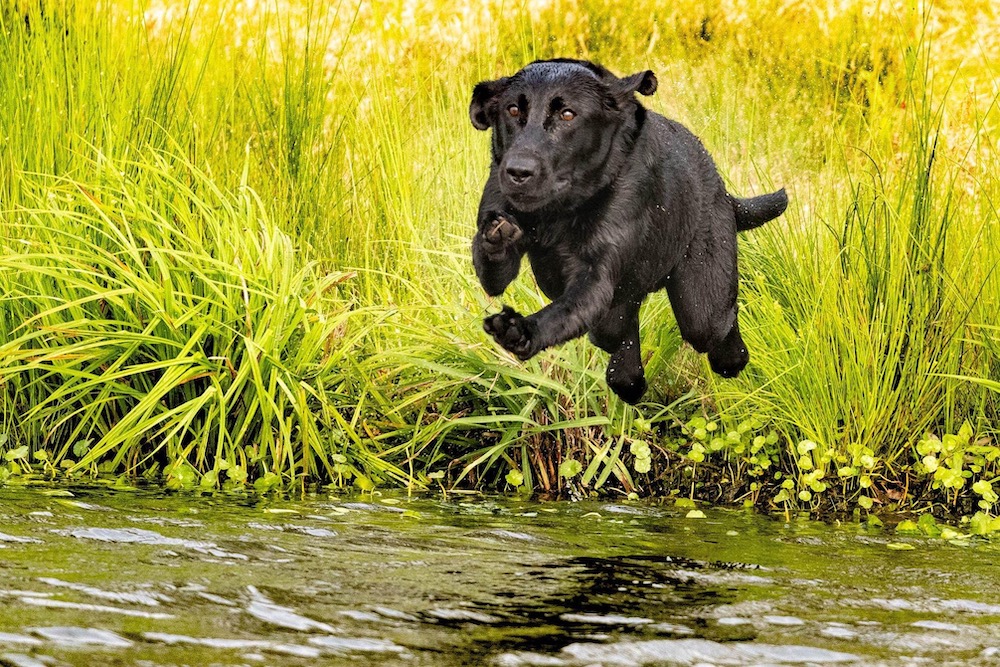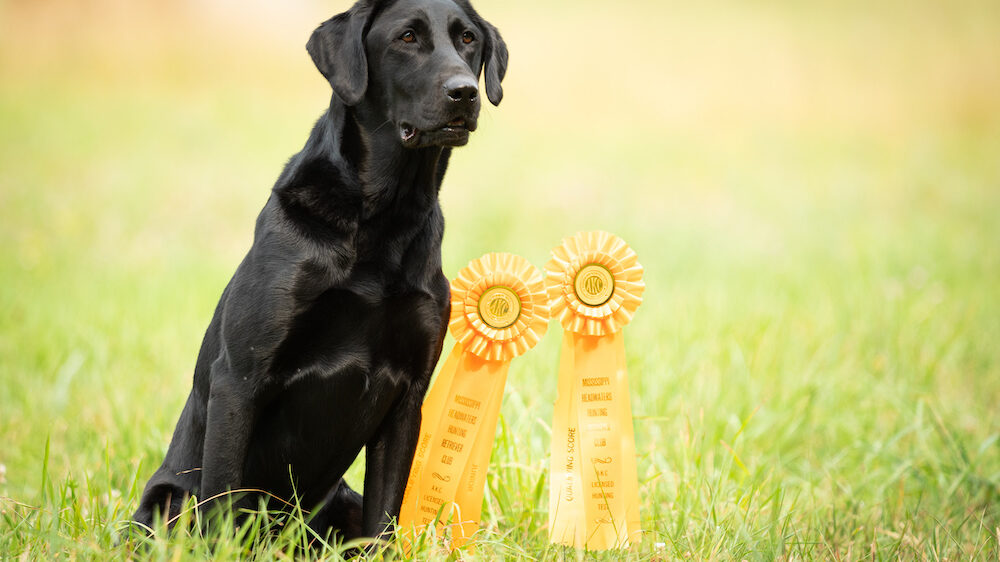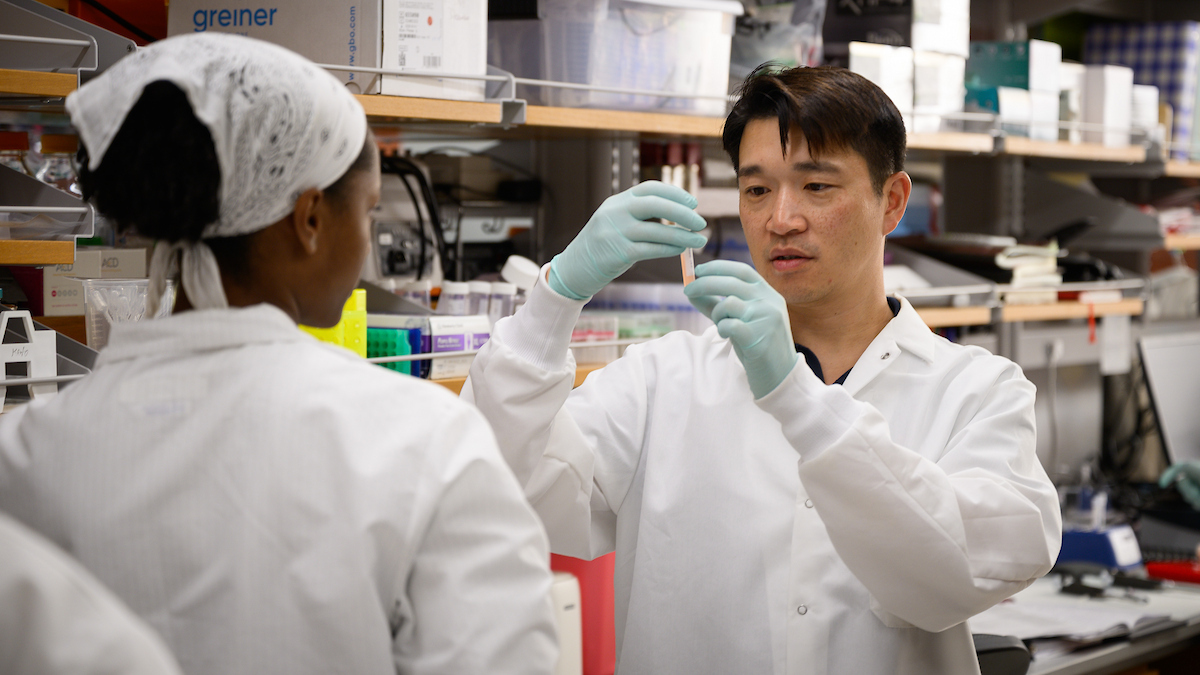A Match Made in Rehab for NC State Veterinary Technician, Hunting Dog

NC State Veterinary Hospital technician Heather Hopkinson sees the tale of Tarpon, a nationally ranked field-trial dog that persevered to hunt again after a devastating injury, as one of a beautiful, extraordinary animal.
To the mind of Duncan Lascelles, however, the hero of the comeback story is Hopkinson. Against amazing odds, Hopkinson helped rehab the black Labrador retriever so he could go back to running after damaging the tendons that anchor his bicep muscles to his shoulder joints.
“The chances of a complete recovery and return to competition activity are pretty slim for this condition and especially for how affected Tarpon was,” says Lascelles, professor of translational pain research and management at the NC State College of Veterinary Medicine. “But I soon realized that if there were ever a patient that had a real chance of fully recovering, this was it. And that was down to the amazing work of Heather.”
Tarpon came to live with Hopkinson, who has been at the NC State Veterinary Hospital 15 years, on a lark.
The dog’s previous owner, Elizabeth Howell, splits her time between Minnesota and North Carolina as she trains two dogs at a time to participate in field trials.
Dogs score by how well they retrieve a duck on land and in water. Tarpon was ranked 57th out of thousands of retrievers under age 2 in the United States, Hopkinson says, and was on the sport’s National Derby list.
While in North Carolina over the winter of 2019, Howell noticed Tarpon was limping consistently and took him to NC State to try to determine why. A CT scan and ultrasound showed both of the dog’s shoulders had tears in the tendons.
“These injuries in rehab are terrible,” says Hopkinson, who has spent the past four years in small animal rehab. “Normally they can’t come back from that and do what they used to do. It’s very hard to rehab.”
Hopkinson jokingly told Howell that if Tarpon ever wanted to become a North Carolina dog, she’d be happy to have him.
“I say that all the time to people, that so and so wants to go home with me,” Hopkinson says. “But I’m a rehab technician, and I knew she had to retire him. When they train, they train every day of the week, 300-yard runs on water and land, and he just couldn’t do that anymore.”
In August 2020, after caring for Tarpon proved too much for one of Howell’s friends, Howell called Hopkinson to see whether she was serious about her offer.

“I’m like, ‘Uh, yes, yes,’” Hopkinson says. “I knew he was going to come to me lame and limping. That’s when I talked to Dr. Lascelles. He said let’s do a three-month trial of nonsteroidal anti-inflammatory drugs, and you can rest him for eight weeks. Then for two months straight, he went swimming five or six days a week.”
Swimming is the best way to rehabilitate dogs, Hopkinson says, because they don’t use their hind legs in the water. They use their shoulders.
Lascelles has spent 30 years researching pain, measuring pain and managing pain. He called Tarpon’s condition neither rare nor common.
“If you’ve ever had a sprain or inflammation of a tendon, you know it’s really difficult to get it to settle down and to go away completely,” he says. “The way to do it is to use anti-inflammatory drugs and very strict rest for eight weeks then to very carefully come back to using that body area. It’s the rest and the careful rehabilitation that is so difficult.”
It sounds simple, Lascelles says, but it’s one of the most difficult things to do.
“Any owner of a dog knows a dog wants to jump around and play and go for a walk,” Lascelles says. “And most people just do not have the patience to do what is needed.”
When Hopkinson asked for his help with Tarpon, Lascelles says, he didn’t have great hope for success.
“My experience is most people can’t do what you’re supposed to do,” he says. “I guess in retrospect, Heather was not ‘most people.’ Heather was superbly dedicated. What Heather did was she listened carefully, asked the right questions and then kept in continued contact with me as Tarpon progressed through this treatment.”
Tarpon’s pain came from the tugging on the inflamed tendons when he moved, Lascelles says, and without eight weeks of rest followed by a careful return to exercise, complete healing would be impossible.
“Heather subscribed to strictly resting Tarpon,” he says. “She used strict kennel rest, which is difficult, but it’s the only chance to get better. She managed this situation beautifully. She really attended to the medical needs but paid attention to Tarpon’s welfare, keeping his mental state healthy during the time he was not allowed to be active. She did an incredible job.”
When you tell most people to start to gradually increase the exercise of a dog, Lascelles says, they have no idea what you mean.
“But Heather really understood that,” he says. “She kept checking with me every week during the rest period and during the rehabilitation period, and it was successful. It just shows you these problems can be managed with the appropriate dedication and knowledge and working with your veterinarian.”
Hopkinson keeps in regular touch with Howell, who was in North Carolina early last year to train her dogs.
I soon realized that if there were ever a patient that had a real chance of fully recovering, this was it. And that was down to the amazing work of Heather.
Hopkinson and Tarpon met up with her over a few weekends, and Hopkinson learned more about Tarpon’s hunting and retrieving past.
“She was like, you’re going to come visit me in Minnesota, and we’re going to get his junior hunter title,” Hopkinson says. “Hunt tests are different from field trials because they’re shorter distances.”
In July, Hopkinson took Tarpon to Minnesota for 2½ weeks, and he trained with Howell and other professionals. After two weekends of hunt testing, he came out with an American Kennel Club junior hunter title.
“He is such a sweet dog,” Hopkinson says. “I can’t believe I’ve ended up with this sweet black lab. I didn’t know anything about Derby lists or any of this. I just knew there was something special about him.”
Lascelles says it’s Hopkinson’s relationship with Tarpon that’s unique.
“What is special is the way she looks after the dog, trains it, manages it and really thinks about the implications of what they’ll both do together and what she asks the dog to do,” he says. “It’s a beautiful relationship. It’s lovely to see.”
~Burgetta Eplin Wheeler
- Categories:


